1969 DATSUN B110 oil
[x] Cancel search: oilPage 38 of 136
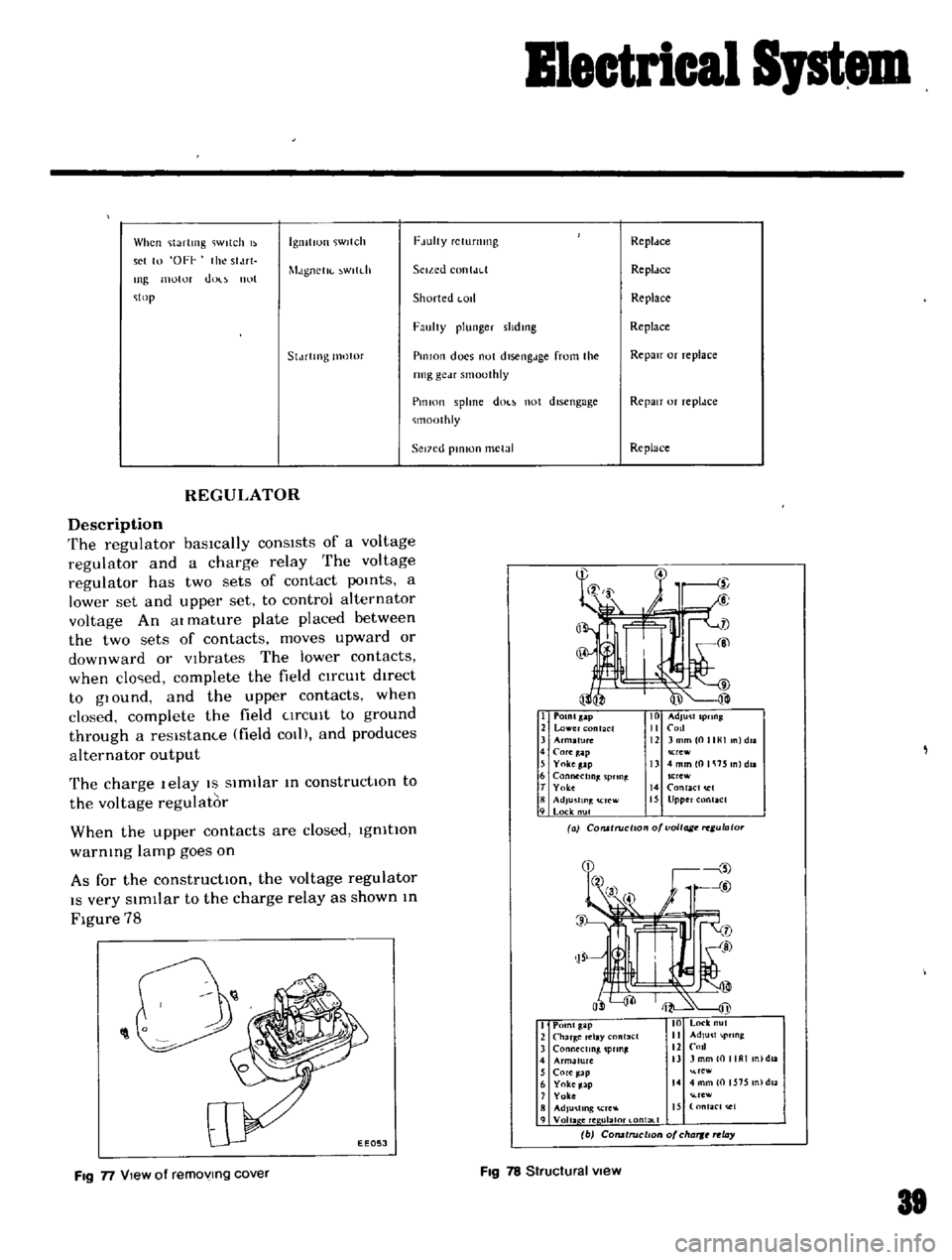
llectrical
Spt
When
Harting
lWltch
I
IgllltlUn
iwltch
FJuhy
rctuflung
Repldce
set
10
OFf
the
slJrl
motor
do
nut
MJgnclK
Wltdl
Seiad
contJr
l
Repldcc
IIlg
I
op
Shorted
1
011
Replace
Faulty
plunger
slidmg
Replace
StJflillg
motOr
Pillion
does
not
dlsengJge
from
the
Repair
or
replace
nng
gedr
smoothly
Pinion
sphne
dot
110t
disengage
Repan
or
replJce
moothly
SCl7Cd
pinIOn
metal
Replace
REGULATOR
Description
The
regulator
basically
consists
of
a
voltage
regulator
and
a
charge
relay
The
voltage
regulator
has
two
sets
of
contact
poInts
a
lower
set
and
upper
set
to
control
alternator
voltage
An
at
mature
plate
placed
between
the
two
sets
of
contacts
moves
upward
or
downward
or
Vibrates
The
lower
contacts
when
clo
ed
complete
the
field
CIrCUIt
dIrect
to
glOund
and
the
upper
contacts
when
closed
complete
the
field
CIrCUIt
to
ground
through
a
resIstam
e
field
COl
and
produces
alternator
output
The
charge
lelay
IS
SimIlar
In
constructIOn
to
the
voltage
regulator
When
the
upper
contacts
are
closed
IgnitIOn
warnIng
lamp
goes
on
As
for
the
constructIOn
the
voltage
regulator
IS
very
SImIlar
to
the
charge
relay
as
shown
In
Figure
78
I
POlnlsap
2
lower
nt
CI
3
Arm2fu1C
4
COfe
ap
5
Yokeg
lp
6
Connecting
pnn
t
T
Yolce
8
AdJu
fln
rcw
9
Lock
nul
Crew
13
4mmlOlli15
nldll
SCrew
14
RlaCI
I
15
Upper
Rlact
a
COlUlruci
o
o
voltage
ulato
O
0
1
EEOSJ
I
Point
gap
2
Char
Clay
nl3el
3
ConMctmg
pun
4
Armature
nl
daa
5
Core
ap
re
6
Yoke
Jap
14
4
mm
0
1575
n
dla
7
Yoke
rew
8
AdJu
llng
Cre
IS
nfaC
t
e1
9
Voila
ere
ulal0t
l
ontal
1
b
COfUtruclton
of
cha
rt
ay
FIg
n
View
of
removing
cover
FIg
78
Structural
view
81
Page 42 of 136

lenition
Sptem
IGNITION
SECONDARY
COI
L
COI
L
CAP
BREAKER
POTNT
cr
r
7
W
tc
l
uToRI
8
TO
STARTER
l
J
ROTOR
HEAD
SPARK
PLUG
Fig
19
Igmtlon
system
Circuit
diagram
The
IgmtlOn
CirCUIt
conSIsts
of
the
distributor
IgmtIon
cOli
IgmtIon
sWitch
spark
plugs
hIgh
tensIOn
cable
and
the
battery
Figure
76
shows
IgmtlOn
CirCUIt
DISTRIBUTOR
Construction
The
dIstributor
consists
of
high
tension
voltage
part
SWitch
off
part
centrifugal
ad
vancing
angle
part
vacuum
advance
mechamcal
part
and
drlvmg
part
Figures
77
and
78
show
the
constructIOn
and
exploded
view
Checking
and
Adjustment
Cap
and
rotor
head
must
always
be
kept
clean
to
maintain
good
insulation
durability
since
high
tensIOn
voltage
from
IgmtIon
cOil
IS
Im
posed
on
them
SometImes
inside
of
the
cap
and
rotor
head
IS
covered
wIth
fine
carbon
partIcles
and
dust
Whenever
crack
or
trace
of
leakage
IS
found
on
the
cap
replace
w1th
a
new
one
44
Recommended
the
rotor
head
also
be
replaced
wIth
a
new
one
If
excessively
damaged
When
pomt
surface
IS
roughened
due
to
bur
nlng
polish
with
a
fine
emery
paper
No
500
or
600
or
011
stone
When
the
point
IS
worn
excessively
replace
When
the
POIn
IS
replaced
with
a
new
one
apply
grease
to
the
arm
pivot
receiver
and
cam
surface
For
causes
of
damaged
burnt
point
Improper
pomt
contact
msufficlent
point
gap
and
defective
condenser
are
conSidered
The
standard
pomt
gap
IS
0
0177
to
0
0217
m
When
gap
IS
devIated
from
the
standard
gap
adjust
Turn
the
shaft
to
a
posItIon
where
the
breaker
arm
heel
rides
the
cam
lug
a
posItIon
where
pomt
gap
IS
maxImum
loosen
the
gap
adjusting
screw
apply
a
thIckness
gauge
bet
ween
contacts
and
adjust
to
the
standard
pomt
gap
When
measurmg
breaker
pomt
spring
ten
SIOn
apply
sprmg
tensIOn
gauge
to
the
breaker
pomt
and
posItIon
the
sprmg
tenslOn
gauge
m
right
angle
agamst
the
breaker
arm
Page 44 of 136
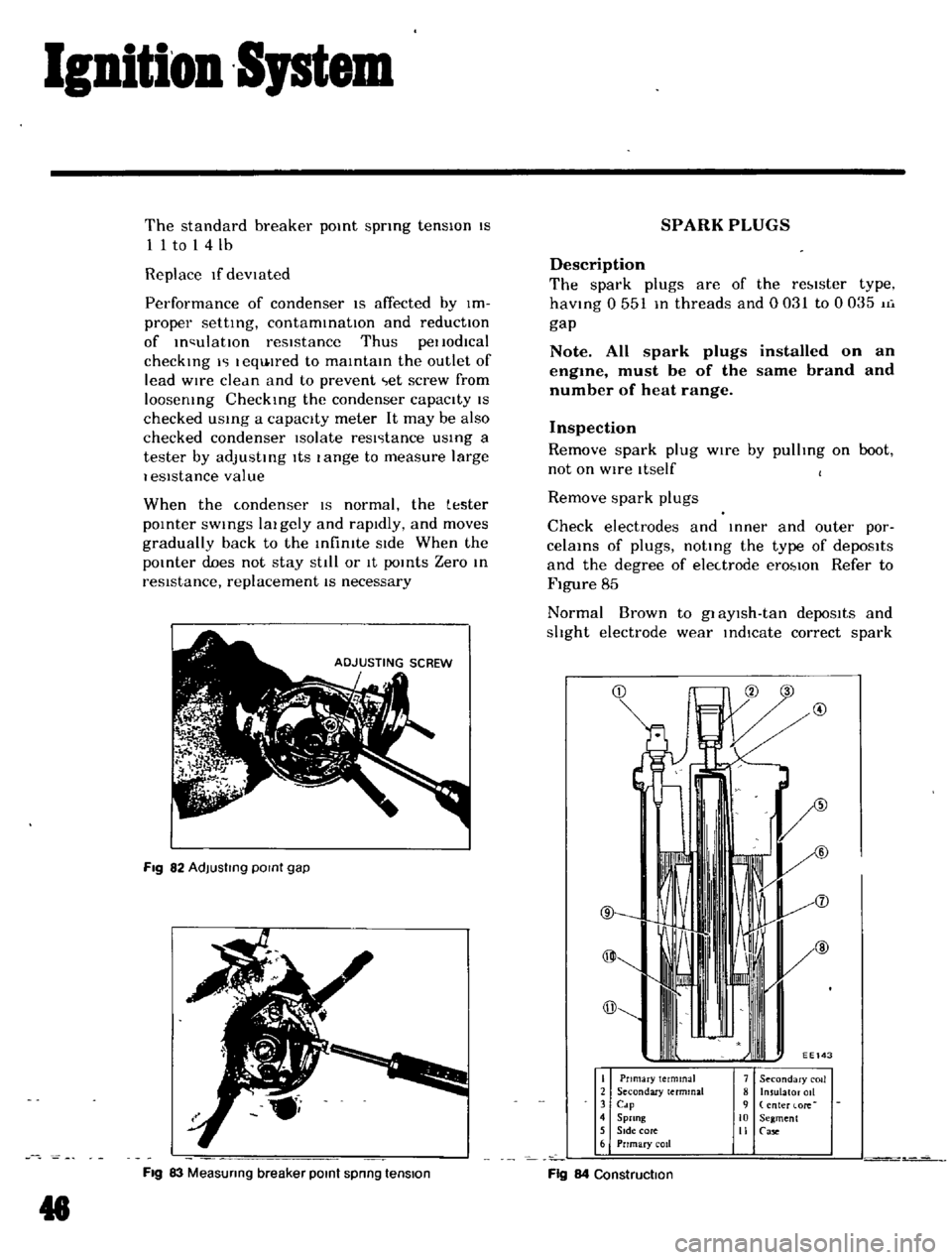
Ignition
Sptem
The
standard
breaker
pOint
spring
tensIOn
IS
1
1
to
1
4
lb
Replace
If
devIated
Performance
of
condenser
IS
affected
by
Im
proper
setting
contaminatIOn
and
reductIOn
of
In
ulatlOn
resIstance
Thus
pellOdlcal
checking
I
I
eqlJ
lred
to
maintain
the
outlet
of
lead
wire
clean
and
to
prevent
et
screw
from
loosening
Checking
the
condenser
capacIty
IS
checked
USing
a
capacity
meter
It
may
be
also
checked
condenser
Isolate
resl
tance
USing
a
tester
by
adjusting
ItS
I
ange
to
measure
large
I
eSlstance
value
When
the
condenser
IS
normal
the
tester
pOinter
SWings
1m
gely
and
rapIdly
and
moves
gradually
back
to
the
Infimte
SIde
When
the
pOinter
does
not
stay
stili
or
It
points
Zero
In
reSIstance
replacement
IS
necessary
Fig
82
AdJusllng
POint
gap
Fig
83
Measunng
breaker
POint
spnng
tension
g
SPARK
PLUGS
Description
The
spark
plugs
are
of
the
re
lster
type
haVing
0
551
In
threads
and
0031
to
0035
11i
gap
Note
All
spark
plugs
installed
on
an
engme
must
be
of
the
same
brand
and
number
of
heat
range
Inspection
Remove
spark
plug
wIre
by
pulhng
on
boot
not
on
WIre
Itself
Remove
spark
plugs
Check
electrodes
and
Inner
and
outer
por
celams
of
plugs
noting
the
type
of
depOSits
and
the
degree
of
electrode
erO
lOn
Refer
to
Figure
85
Normal
Brown
to
gl
aYlsh
tan
depoSits
and
shght
electrode
wear
indIcate
correct
spark
@
I
Pnmary
terminal
2
Secondary
terminal
3
Cdp
4
Sprang
5
SIde
core
6
Prrmary
coil
7
Secondary
COIl
8
Insulator
011
9
enter
lore
10
Segment
II
Case
Fig
84
Construction
Page 45 of 136
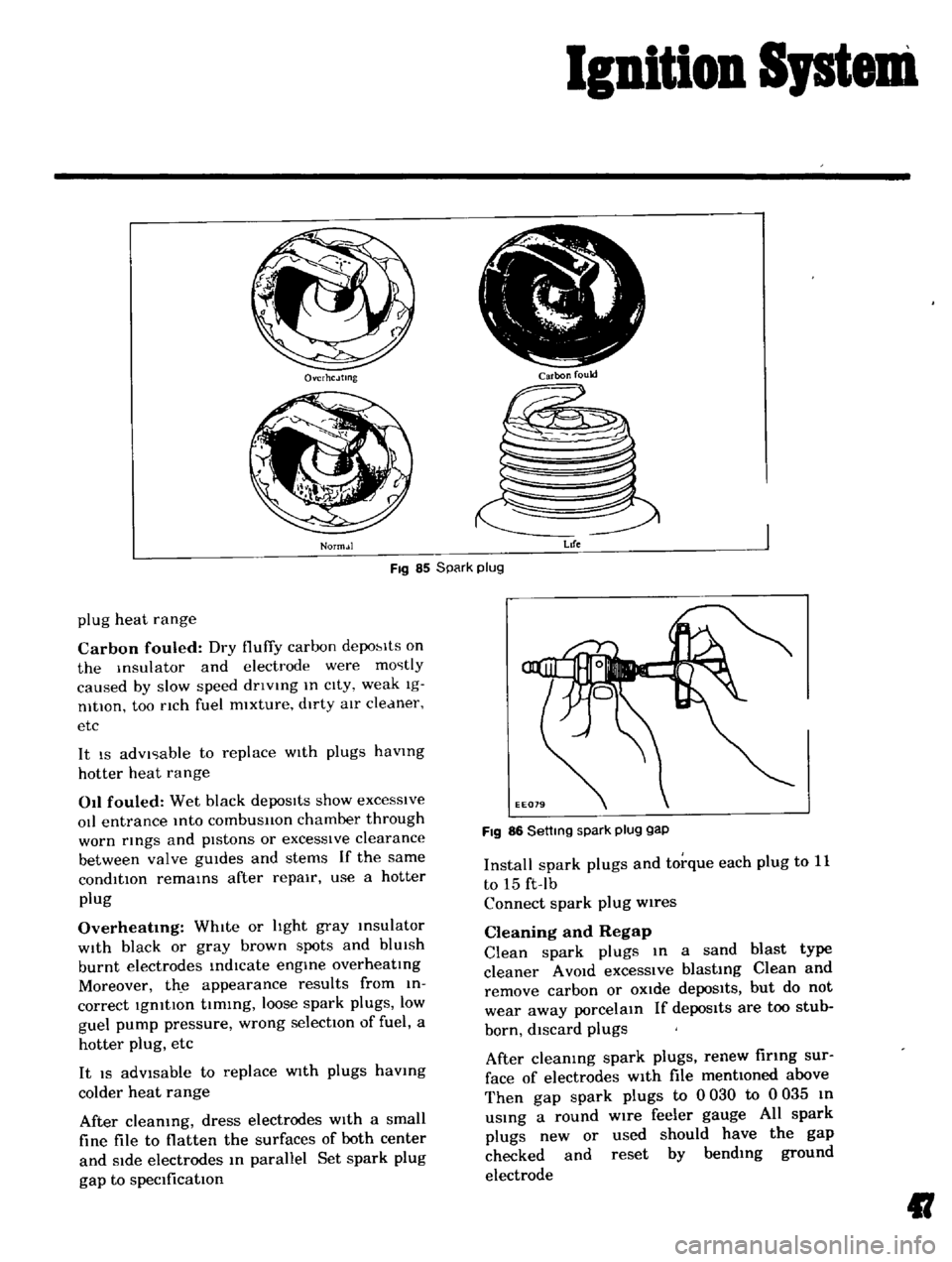
Icnition
Sptem
Ovcrhc
Jtmg
Norm
Jl
i
r
rJ
I
ttr
I
i
V
Carbon
fould
Fig
85
Spark
plug
Life
plug
heat
range
Carbon
fouled
Dry
fluffy
carbon
depo
lts
on
the
Insulator
and
electrode
were
mostly
caused
by
slow
speed
dnvlng
In
cIty
weak
Ig
nltlOn
too
nch
fuel
mixture
dirty
aIr
cleaner
etc
It
IS
advIsable
to
replace
WIth
plugs
havmg
hotter
heat
range
011
fouled
Wet
black
depoSits
show
excesSive
oIl
entrance
Into
combusllon
chamber
through
worn
rmgs
and
pIstons
or
excessIve
clearance
between
valve
gUIdes
and
stems
If
the
same
condition
remams
after
repair
use
a
hotter
plug
Overheatmg
WhIte
or
hght
gray
msulator
WIth
black
or
gray
brown
spots
and
blUIsh
burnt
electrodes
indIcate
engme
overheatIng
Moreover
th
e
appearance
results
from
in
correct
IgnitIon
tIming
loose
spark
plugs
low
guel
pump
pressure
wrong
selectIOn
of
fuel
a
hotter
plug
etc
It
IS
adVisable
to
replace
WIth
plugs
havmg
colder
heat
range
After
cleaning
dress
electrodes
With
a
small
fine
file
to
flatten
the
surfaces
of
both
center
and
Side
electrodes
In
parallel
Set
spark
plug
gap
to
specification
FIg
86
Settmg
spark
plug
gap
Install
spark
plugs
and
torque
each
plug
to
11
to
15
ft
Ib
Connect
spark
plug
wires
Cleaning
and
Regap
Clean
spark
plugs
In
a
sand
blast
type
cleaner
A
VOId
excessIve
blasting
Clean
and
remove
carbon
or
OXide
depoSits
but
do
not
wear
away
porcelain
If
depos1ts
are
too
stub
born
discard
plugs
After
cleaning
spark
plugs
renew
firing
sur
face
of
electrodes
With
file
mentioned
above
Then
gap
spark
plugs
to
0
030
to
0
035
In
uSing
a
round
wire
feeler
gauge
All
spark
plugs
new
or
used
should
have
the
gap
checked
and
reset
by
bending
ground
electrode
II
Page 58 of 136
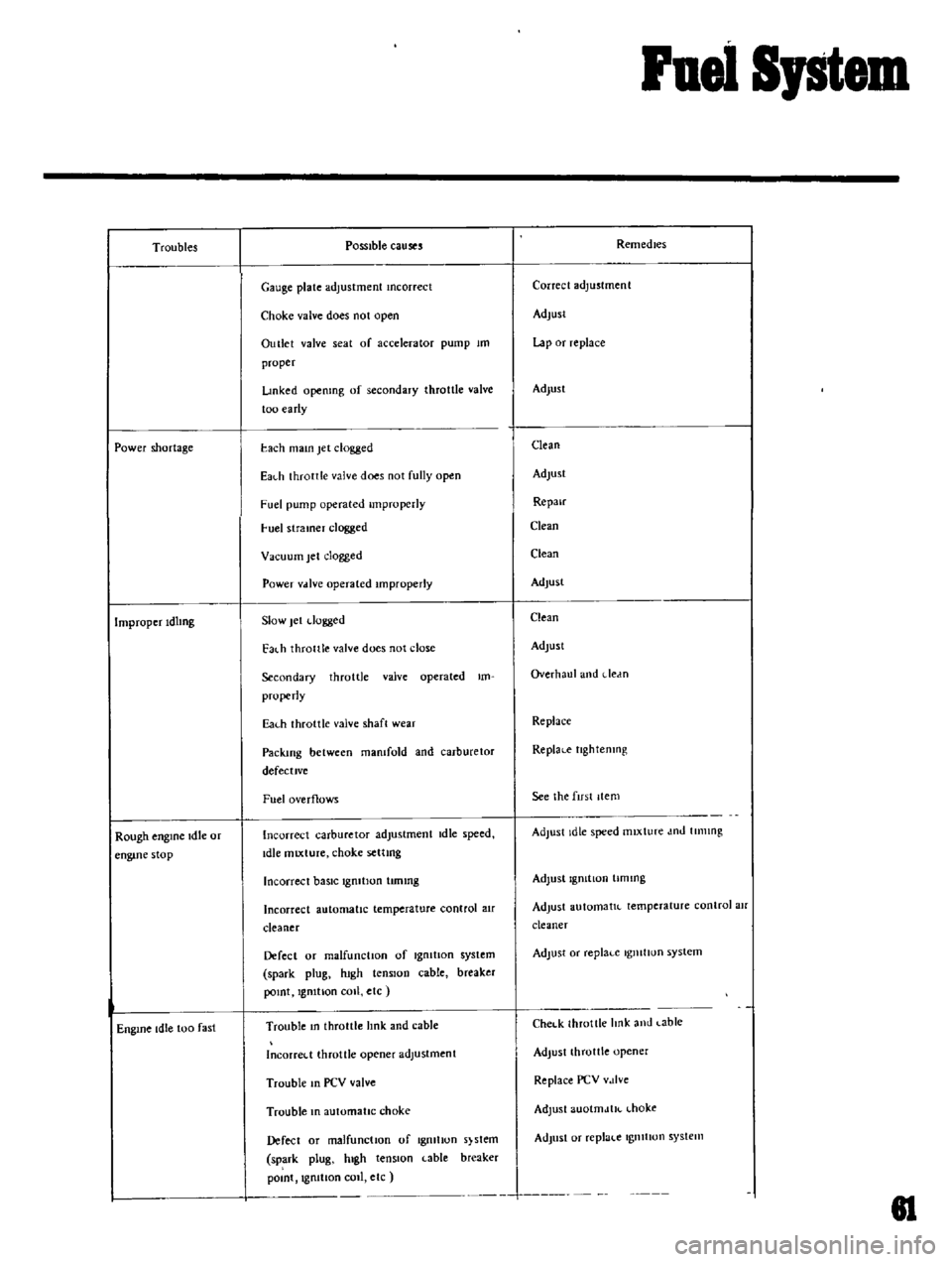
ruel
Sptem
Troubles
Power
shortage
Improper
IdlIng
Rough
engIne
Idle
or
eogme
stop
Engme
Idle
too
fast
Possible
causes
Gauge
plate
adjustment
mcorrect
Choke
valve
does
not
open
Outlet
valve
seat
of
accelerator
pump
1m
proper
Lmked
openmg
of
secondary
throttle
valve
too
early
each
mam
Jet
clogged
EaLh
throttle
valve
does
not
fully
open
Fuel
pump
operated
Improperly
uel
stramer
clogged
Vacuum
Jet
clogged
Power
vdlve
operated
Improperly
Slow
Jel
dugged
Fat
h
thronle
valve
does
not
close
Secondary
throttle
valve
operated
Im
properly
Eal
h
throttle
valve
shaft
wear
Packing
between
mamfold
and
carburetor
defective
Fuel
overflows
Incorrect
carburetor
adjustment
Idle
speed
Idle
miXture
choke
settmg
Incorrect
baSIC
1
OIt100
tunmg
Incorrect
automatic
temperature
control
air
cleaner
Defect
or
malfunction
of
Igmtlon
system
spark
plug
lugh
tenSion
cable
breaker
JX
Int
Ignition
COIl
etc
Trouble
In
throttle
lInk
and
cable
Incorred
throttle
opener
adjustment
Trouble
In
PCV
valve
Trouble
In
automatic
choke
Defect
or
malfunctIOn
of
Igmhon
s
stem
spark
plug
hIgh
tenSion
cable
breaker
pomt
Ignition
Call
elc
Remedies
Correct
adjustment
Adjust
Lap
or
replace
Adlust
Clean
Adjust
Repair
Clean
Clean
Adlust
Clean
Adlusl
Overhaul
and
dedn
Replace
ReplaLe
tlghtenlllg
See
the
fust
Item
Adjust
Idle
speed
mixture
dnd
tUllIng
Adjust
19mtlon
timing
Adjust
automatlL
temperature
control
air
cleaner
Adjust
or
replaLe
IgllltIun
system
Chel
k
throttle
hnk
and
Lable
Adjust
throttle
opener
Replace
PCV
vJlve
Adjust
auotmJtIL
l
hoke
Adjust
or
replac
e
IgllltIun
system
J
81
Page 64 of 136
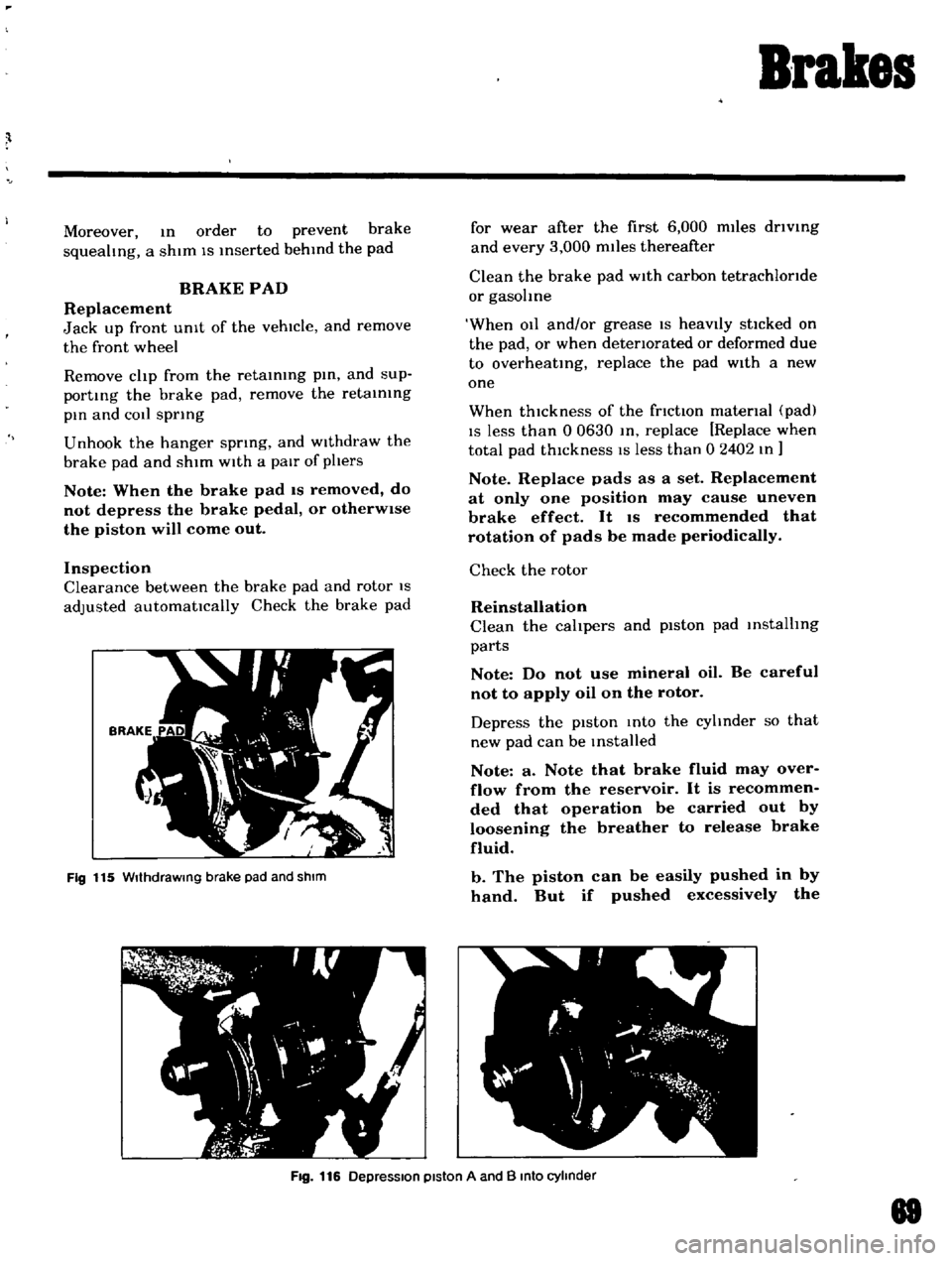
r
Brakes
Moreover
In
order
to
prevent
brake
squeahng
a
shIm
IS
Inserted
behind
the
pad
BRAKE
PAD
Replacement
Jack
up
front
UnIt
of
the
vehicle
and
remove
the
front
wheel
Remove
clip
from
the
retaining
pin
and
sup
porting
the
brake
pad
remove
the
retaining
pin
and
COil
spring
Unhook
the
hanger
spring
and
Withdraw
the
brake
pad
and
shim
With
a
pair
of
phers
Note
When
the
brake
pad
IS
removed
do
not
depress
the
brake
pedal
or
otherWise
the
piston
will
come
out
Inspection
Clearance
between
the
brake
pad
and
rotor
IS
adjusted
automatically
Check
the
brake
pad
Fig
115
WIthdraWing
brake
pad
and
shIm
for
wear
after
the
first
6
000
miles
driVing
and
every
3
000
miles
thereafter
Clean
the
brake
pad
With
carbon
tetrachloride
or
gasohne
When
011
and
or
grease
IS
heavIly
stlcked
on
the
pad
or
when
deteriorated
or
deformed
due
to
overheating
replace
the
pad
With
a
new
one
When
thickness
of
the
friction
material
pad
IS
less
than
0
0630
In
replace
Replace
when
total
pad
thIckness
IS
less
than
0
2402
In
Note
Replace
pads
as
a
set
Replacement
at
only
one
position
may
cause
uneven
brake
effect
It
IS
recommended
that
rotation
of
pads
be
made
periodically
Check
the
rotor
Reinstallation
Clean
the
calipers
and
piston
pad
installing
parts
Note
Do
not
use
mineral
oil
Be
careful
not
to
apply
oil
on
the
rotor
Depress
the
pIston
Into
the
cyhnder
so
that
new
pad
can
be
Installed
Note
a
Note
that
brake
fluid
may
over
flow
from
the
reservoir
It
is
recommen
ded
that
operation
be
carried
out
by
loosening
the
breather
to
release
brake
fluid
b
The
piston
can
be
easily
pushed
in
by
hand
But
if
pushed
excessively
the
Fig
116
DepreSSion
piston
A
and
B
Into
cylinder
88
Page 65 of 136
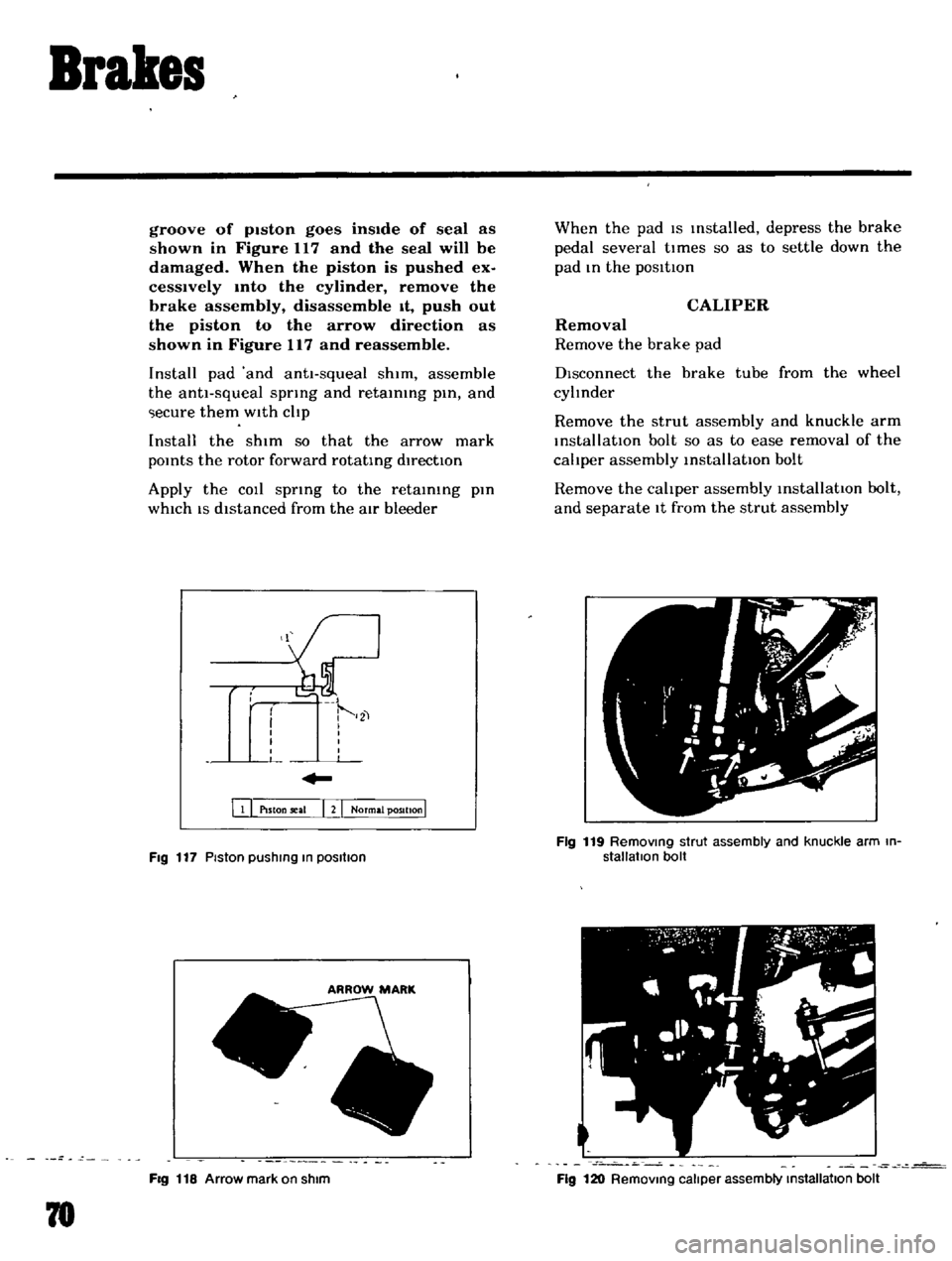
Brakes
groove
of
pIston
goes
insIde
of
seal
as
shown
in
Figure
117
and
the
seal
will
be
damaged
When
the
piston
is
pushed
ex
cesslvely
mto
the
cylinder
remove
the
brake
assembly
disassemble
It
push
out
the
piston
to
the
arrow
direction
as
shown
in
Figure
117
and
reassemble
Install
pad
and
antt
squeal
shim
assemble
the
anti
squeal
spring
and
retaining
pin
and
ecure
them
with
cltp
Install
the
shim
so
that
the
arrow
mark
pOints
the
rotor
forward
rotating
directIOn
Apply
the
COIl
spring
to
the
retaining
pin
which
IS
distanced
from
the
atr
bleeder
111
PlSton
seal
I
2
I
Normal
position
I
Fig
117
Piston
pushIng
In
posllIon
FIg
118
Arrow
mark
on
shim
78
When
the
pad
IS
Installed
depress
the
brake
pedal
several
tl
mes
so
as
to
settle
down
the
pad
In
the
posltton
CALIPER
Removal
Remove
the
brake
pad
DIsconnect
the
brake
tube
from
the
wheel
cyltnder
Remove
the
strut
assembly
and
knuckle
arm
installatIOn
bolt
so
as
to
ease
removal
of
the
cahper
assembly
installatIOn
bolt
Remove
the
cahper
assembly
installatIOn
bolt
and
separate
It
from
the
strut
assembly
Fig
119
RemOVing
strut
assembly
and
knuckle
arm
in
stallatIon
bolt
Fig
120
RemOVing
caliper
assembly
Installallon
bolt
Page 66 of 136
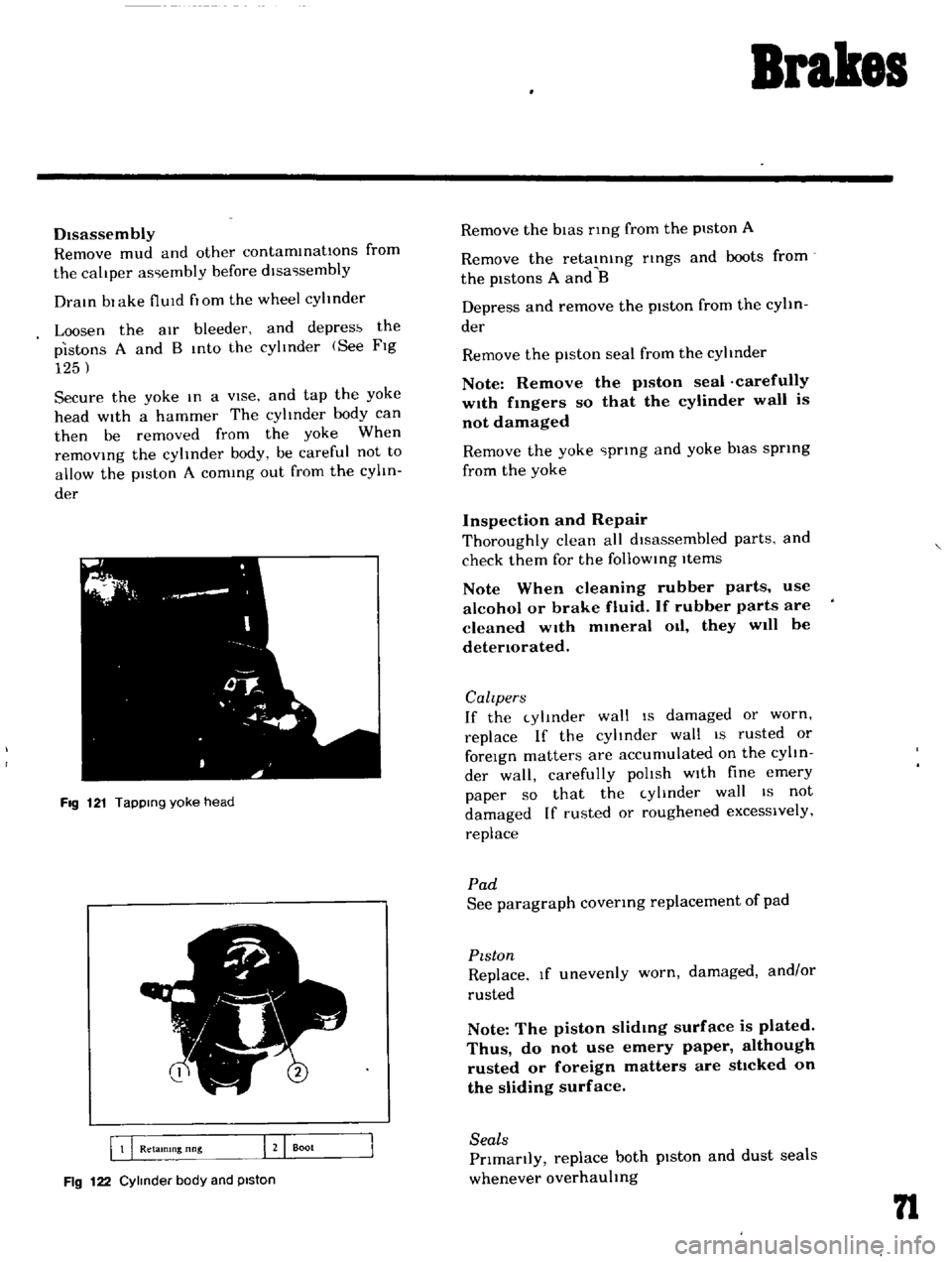
Brakes
DIsassembly
Remove
mud
and
other
contamInations
from
the
caLiper
as
embly
before
dlsa
sembly
DraIn
bl
ake
fluId
flOm
the
wheel
cylinder
Loosen
the
aIr
bleeder
and
depres
the
pistons
A
and
B
Into
the
cylInder
See
FIg
125
Secure
the
yoke
In
a
vIse
and
tap
the
yoke
head
with
a
hammer
The
cylinder
body
can
then
be
removed
from
the
yoke
When
remOVIng
the
cylinder
body
be
careful
not
to
allow
the
piston
A
comIng
out
from
the
cylIn
der
FIg
121
TapPing
yoke
head
5
I
B
Q
Retamlng
nng
J
Boot
Fig
122
Cylinder
body
and
piston
Remove
the
bIas
nng
from
the
piston
A
Remove
the
retaInIng
nngs
and
boots
from
the
pistons
A
and
B
Depress
and
remove
the
piston
from
the
cylin
der
Remove
the
piston
seal
from
the
cylinder
Note
Remove
the
p1ston
seal
carefully
w1th
fmgers
so
that
the
cylinder
wall
is
not
damaged
Remove
the
yoke
prIng
and
yoke
bias
sprIng
from
the
yoke
Inspection
and
Repair
Thoroughly
clean
all
dIsassembled
parts
and
check
them
for
the
follOWIng
Items
Note
When
cleaning
rubber
parts
use
alcohol
or
brake
fluid
If
rubber
parts
are
cleaned
wIth
mmeral
Oil
they
will
be
detenorated
Calzpers
If
the
cylInder
wall
IS
damaged
or
worn
replace
If
the
cylinder
wall
IS
rusted
or
foreIgn
matters
are
accumulated
on
the
cylIn
der
wall
carefully
polIsh
wIth
fine
emery
paper
so
that
the
cylInder
wall
IS
not
damaged
If
rusted
or
roughened
excessively
replace
Pad
See
paragraph
covenng
replacement
of
pad
PIston
Replace
If
unevenly
worn
damaged
and
or
rusted
Note
The
piston
slidmg
surface
is
plated
Thus
do
not
use
emery
paper
although
rusted
or
foreign
matters
are
sttcked
on
the
sliding
surface
Seals
Prlmanly
replace
both
pIston
and
dust
seals
whenever
overhauling
n